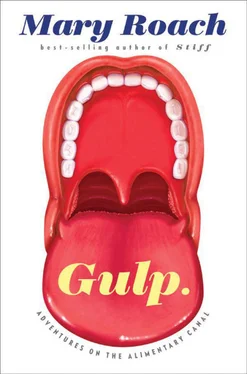Like this: “Dried cherries. Molasses—blackstrap.” Langstaff is sniffing a strong, dark ale called Noel. We are at Beer Revolution, an amply stocked, mildly skunky [6] “Skunky” is between “rotten egg” and “canned corn” on the Defects Wheel for Beer. (Langstaff designed diagnostic wheels for off-flavors in wine, beer, and olive oil.) In the absence of skunks, a mild rendition of skunkiness is achieved by oxidating beer, that is, exposing it to air, as by spilling it or leaving out half-filled glasses.
bar in Oakland, California, where I have an office (in the city, not the bar) and Langstaff has a parent in the hospital. She could use a drink, and we have four. For demonstration purposes.
In general, Langstaff isn’t a talky person. Her sentences present in low, unhurried tones without italics or exclamation points. The question “Which beer do you want, Mary?” went down at the end. When she puts her nose to a glass, though, something switches on. She sits straighter and her words come out faster, lit by interest and focus. “It smells like a campfire to me also. Smokey, like wood, charred wood. Like a cedar chest, like a cigar, tobacco, dark things, smoking jackets.” She sips from the glass. “Now I’m getting the chocolate in the mouth. Caramel, cocoa nibs…”
I sniff the ale. I sip it, push it around my mouth, draw blanks. I can tell it’s intense and complex, but I don’t recognize any of the components of what I’m experiencing. Why can’t I do this? Why is it so hard to find words for flavors and smells? For one thing, smell, unlike our other senses, isn’t consciously processed. The input goes straight to the emotion and memory centers. Langstaff’s first impression of a scent or flavor may be a flash of color, an image, a sense of warm or cool, rather than a word. Smoking jackets in a glass of Noel, Christmas trees in a hoppy, resinous India pale ale.
It’s this too: Humans are better equipped for sight than for smell. We process visual input ten times faster than olfactory. Visual and cognitive cues handily trump olfactory ones, a fact famously demonstrated in a 2001 collaboration between a sensory scientist and a team of oenologists (wine scientists) at the University of Bordeaux in Talence, France. Fifty-four oenology students were asked to use standard wine-flavor descriptors to describe a red wine and a white wine. In a second round of tasting, the same white wine was paired with a “red,” which was actually the same white wine yet again but secretly colored red. (Tests were run to make sure the red coloring didn’t affect the flavor.) In describing the red-colored white wine, the students dropped the white wine terms they’d used in the first round in favor of red wine descriptors. “Because of the visual information,” the authors wrote, “the tasters discounted the olfactory information.” They believed they were tasting red wine.
Verbal facility with smells and flavors doesn’t come naturally. As babies, we learn to talk by naming what we see. “Baby points to a lamp, mother says, ‘Yes, a lamp,’” says Johan Lundström, a biological psychologist with the Monell Chemical Senses Center in Philadelphia. “Baby smells an odor, mother says nothing.” All our lives, we communicate through visuals. No one, with a possible exception made for Sue Langstaff, would say, “Go left at the smell of simmering hotdogs.”
“In our society, it’s important to know colors,” Langstaff says over a rising happy-hour din. We need to know the difference between a green light and a red light. It’s not so important to know the difference between bitter and sour, skunky and yeasty, tarry and burnt. “Who cares. They’re both terrible. Ew. But if you’re a brewer, it’s extremely important.” Brewers and vintners learn by exposure, gradually honing their focus and deepening their awareness. By sniffing and contrasting batches and ingredients, they learn to speak a language of flavor. “It’s like listening to an orchestra,” Langstaff says. At first you hear the entire sound, but with time and concentration you learn to break it down, to hear the bassoon, the oboe, the strings. [7] In 2010, inventor George Eapen and snack-food giant Frito-Lay took the comparison beyond the realm of metaphor. They patented a system whereby snack-food bags could be printed with a bar code allowing consumers to retrieve and download a fifteen-second audio clip of a symphonic interlude, with the different instruments representing the various flavor components. Eapen, in his patent, used the example of a salsa-flavored corn chip. “A piano intro begins upon the customer’s perception of the cilantro flavoring…. The full band section occurs at approximately the time that the consumer perceives the tomatillo and lime flavors…. A second melody section corresponds to the sensation of the heat burn imparted by the Serrano chili.” U.S. Patent No. 7,942,311 includes sheet music for the salsa-flavored chip experience.
As with music, some people seem born to it. Maybe they have more olfactory receptors or their brain is wired differently, maybe both. Langstaff liked to sniff her parents’ leather goods as a small child. “Purses, briefcases, shoes,” she says. “I was a weird kid.” My wallet is on the table, and without thinking, I stick it under her nose. “Yeah, nice,” she says, though I don’t see her sniff. The performing-chimp aspect of the work gets tiresome.
While not discounting genetic differences, Langstaff believes sensory analysis is mainly a matter of practice. Amateurs and novices can learn via kits, such as Le Nez du Vin, made up of many tiny bottles of reference molecules: isolated samples of the chemicals that make up the natural flavors.
A quick word about chemicals and flavors. All flavors in nature are chemicals. That’s what food is. Organic, vine-ripened, processed and unprocessed, vegetable and animal, all of it chemicals. The characteristic aroma of fresh pineapple? Ethyl 3-(methylthio)propanoate, with a supporting cast of lactones, hydrocarbons, and aldehydes. The delicate essence of just-sliced cucumber? 2 E ,6 Z -Nonadienal. The telltale perfume of the ripe Bartlett pear? Alkyl (2 E ,4 Z )-2,4-decadienoates.
OF THE FOUR half-pints on the table between us, Langstaff prefers the lightest, a strawberry wheat beer. I like the IPA best, but to her that’s not a “sitting and sipping” beer. It’s something she’d drink with food.
I ask Sue Langstaff—sensory consultant to the brewing industry for twenty-plus years, twice a judge at the Great American Beer Festival—what she’d order right now if she had to choose between an IPA and a Budweiser.
“I’d get Bud.”
“Sue, no.”
“Yes!” First exclamation point of the afternoon. “People pooh-pooh Bud. It’s an extremely well-made beer. It’s clean, it’s refreshing. If you’re mowing the lawn and you come in and you want something refreshing and thirst-quenching, you wouldn’t drink this.” She indicates the IPA.
Of all the descriptors in the Beer Flavor Lexicon I brought with me today, Langstaff would apply just two to Bud: malty and worty. She warns me about equating complexity with quality. “All that stuff you read on wine bottles, in wine magazines , where they throw out a dozen descriptors? That’s not sensory evaluation. That’s marketing.”
Taste—as in personal preference, discernment—is subjective. It’s ephemeral, shaped by trends and fads. It’s one part mouth and nose, two parts ego. Even flavors that professional evaluators agree are “defects” can come to signify superior taste. Langstaff mentions a small brewery in northern California that has been taking its beers right up to the doorstep of defective, adding strains of bacteria known for their spoilage effects. Whether through exposure or a desire to ride the cutting edge, people can acquire a taste for pretty much anything. If they can come to like the smelly-foot stink of Limburger cheese or the corpsey reek of durian fruit, they can come to enjoy bacteria-soured beer. (One assumes there are limits, however. Leaving olive oil in contact with rotting sediment at the bottom of a tank can create flavors enumerated on Langstaff’s Defects Wheel for Olive Oil as follows: “baby diapers, manure, vomit, bad salami, sewer dregs, pig farm waste pond.”)
Читать дальше












